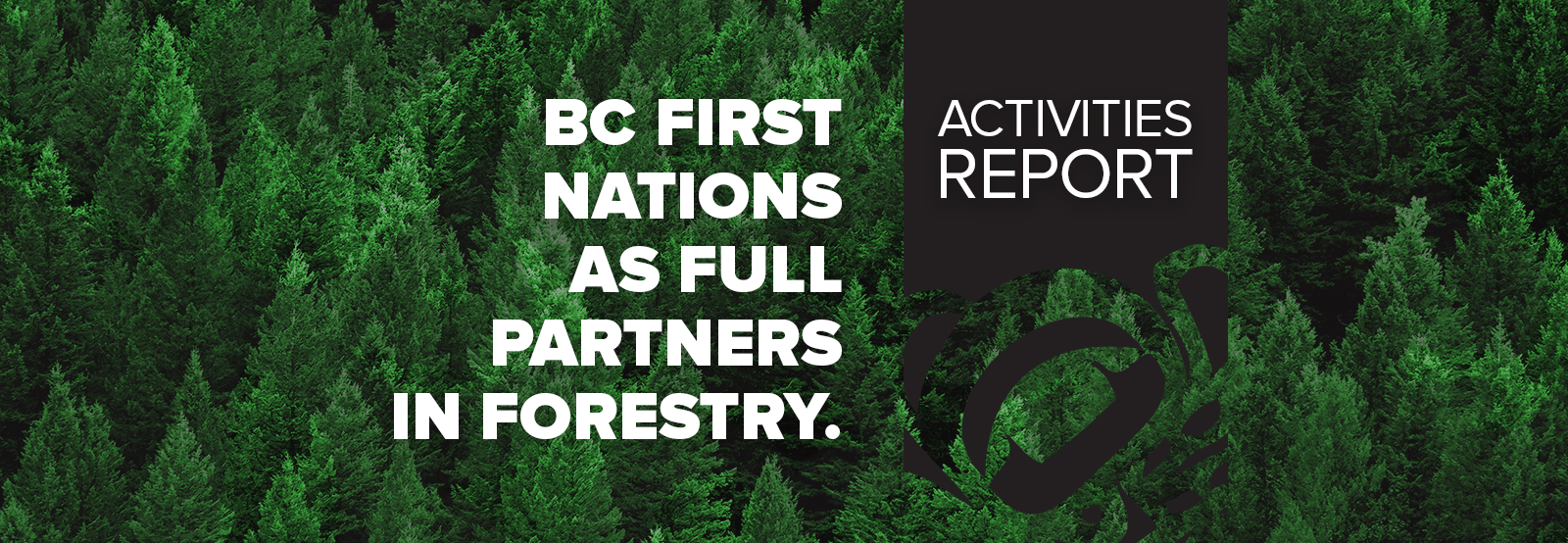A New Way Forward
Letter from Chief Bill Williams, President & Chair

The BC First Nations Forestry Council (the ‘Forestry Council’) wishes to acknowledge and give thanks for the support of the First Nations Leadership Council, who have been strong advocates for the role we play in supporting the Nations. I also wish to acknowledge our Board for their leadership through challenging times, and our staff for providing a strong voice in advocating and providing technical advice that serves our communities.
I would also like to give thanks to Keith Atkinson, who stepped down as CEO after 10 years in 2018, for his excellent leadership. And it is our incoming CEO, Dr. Charlene Higgins, who will continue the advocacy work of the Forestry Council going forward.
Since time immemorial, BC First Nations have lived and relied on forest lands and resources. To our communities, these lands have always been vital sources for trade, food, shelter, and medicine.
Since time immemorial, BC First Nations have lived and relied on forest lands and resources. To our communities, these lands have always been vital sources for trade, food, shelter, and medicine. The forests are also entrenched in our spiritual and cultural practices. This is what has guided our Vision to assist Nations in creating “a healthy forest that continues to sustain the cultural, spiritual, economic and social lives of BC’s First Nations through respectful government-to-government relationships.” We remain committed to this vision.
Over the last three years we worked collaboratively with the province to reach out and engage with the Nations on the development of a BC & First Nations Forest Strategy that recognizes First Nations as governments and rights holders. The Strategy provides a pathway for advancing Nations’ interests and priorities, including changes needed to the forest revenue sharing model to meaningfully share in the benefits derived from lands and resources in their territories.
The focus now must be on a new way forward informed by the implementation of the BC & First Nations Forest Strategy. The time for talk is over. These are historic times. As we move forward with the BC Government’s commitment to the implementation of the UN Declaration on the Rights of Indigenous Peoples and the passing of Bill 41 (DRIPA), we remain committed to supporting Nations to advance their voice, rights, and interests to increase their rightful role as owners in the governance and stewardship of forest lands and resources.
All my relations,
Chief Bill Williams
President, BC First Nations Forestry Council
Letter from Dr. Charlene Higgins, CEO
Greetings to all,
I am honoured to take on the position of Chief Executive Officer to continue the advocacy work of the BC First Nations Forestry Council (the ‘Forestry Council’), and to step into Keith Atkinson’s role after working closely with him for over 10 years.
The Forestry Council has continued its work advocating for an increased role of First Nations in the governance and stewardship of forest lands and resources, including access to an equitable share of benefits. This has been led by engagement with Nations to bring their voices and priorities forward in the changes needed to forest policies, legislation, and practices to increase their participation in the forest sector.
Over the last couple of years, we have developed tools and resources to help guide and inform the incorporation of Indigenous values and principles in land-use planning and stewardship. The focus of our work has involved the development of a BC & First Nations Forest Strategy (the ‘Forest Strategy’), in collaboration with the province, and informed by direct input from First Nations over five years.
The development of a new BC First Nations Forestry Workforce Strategy has also supported the growth of partnerships and programs that are fundamental in linking Indigenous talent to employment and training opportunities in the BC forest sector.
The Indigenous Forestry Scholarship Program saw amazing results in growth and success this year, with four students making their Dean’s List.
We were also honoured to welcome over 184 attendees at our first ever BC First Nations Forestry Conference in June 2019. The three day event saw the launch of the BC & First Nations Forest Strategy and Implementation Plan, showcased forestry workforce opportunities, and First Nations’ Industry partnerships.
There has been a lot of talk over the past decade; now it’s time for action. The future is about change.
The Forest Strategy implements UNDRIP, advances reconciliation, shared decision-making, and supports partnerships with industry and others to provide jobs, building a strong, inclusive way forward with First Nations as full partners. Together, the Forest Strategy and Bill 41 (DRIPA) provide a new way forward that will increase certainty, encourage future investments, and support the longevity of the forest sector for generations to come.
We look forward to continuing our work with BC First Nations to ensure the province lives up to their commitment to develop and implement a shared vision for a revitalized BC forest sector that includes First Nations as full partners. We are here to listen to your recommendations and concerns, and continue to advocate for the changes needed to forest legislation, policies, and practices to better reflect First Nations’ rights, values, and priorities.
Together we can make change happen. #ItsTime
Respectfully,
Dr. Charlene Higgins
CEO, BC First Nations Forestry Council



